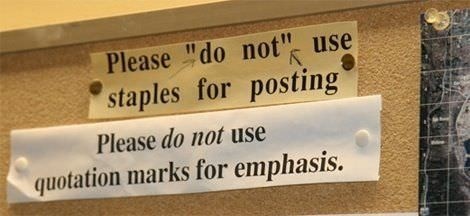Grammar Lesson – Quotation Marks
Quotation marks serve a few different purposes in English grammar. Here are the three main rules:
Rule One: To indicate speech – Quotation marks indicate that someone is speaking.
Example: “Don’t walk in the street,” Julie said to her children.
Rule Two: To quote or cite – Quotation marks also indicate that some writing or information has been taken directly (word for word) from another source.
Example: The safety code at our workplace says that “the shelter in place drill is the most important safety drill we perform” and that it is important that every employee know how the drill works (the words “the shelter in place drill is the most important safety drill we perform” were taken word for word from the safety code).
Rule Three: To indicate sarcasm or that something is approximate – Placing a word in quotation marks indicates that the writer does not intend the word literally. They may even mean the opposite of the word.
Examples:
I “love” to go to the dentist. = I don’t really like going to the dentist.
We had a safety “drill.” = It wasn’t really a drill. It was more like a real emergency.
He was “polite.” = He was polite, but he was also a jerk.
Why is this important?
A lot of people mistakenly think that quotation marks can be used to emphasize words. They use quotation marks when they should use bold or underlining. This is particularly bad when used in advertising. Think about the rule above, and think about what these sentences really mean:
- We have farm “fresh” eggs.
- Our repair men are the most “reliable”.
- Get a “bargain” at our shop.
Note the problems with the quotation marks in these signs:


In this instance, someone recognized and then remedied the quotation marks problem:

References
Figs.1-3. "40 'Signs' with Inappropriate use of Quotation Marks." Lifebuzz.com

